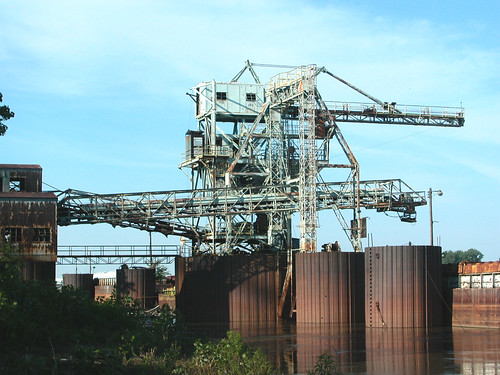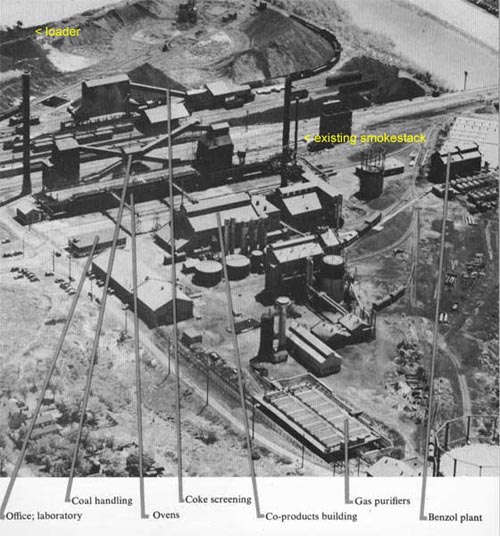I have published a basic history of the site and documented the buildings over the years. However, I never expected the buildings to be preserved. The site is contaminated widely with many substances related to the coke production process, which began at the site in 1915.
Still, there are two resources on the site whose preservation would require minimal loss of usable site and whose presence would provide the new industrial park with readily-identified icons. Given that the coke plant was one of the largest employers in the Patch section of Carondelet for over 60 years, some tangible link with the industrial past is fitting. Thousands of area residents worked at the plant, enduring the emission-laden landscape to support their families. Why not allow future generations the chance to see something when they visit the site where a grandfather or great-grandfather once worked?
 The most obvious resources to preserve is the remaining brick smokestack, which stands at the south end of the coke oven battery. This was one of two stacks that relieved the smoke from the ovens. This stack dates to the ownership period of Great Lakes Carbon Company, which owned the plant from 1950 through 1980. Being constructed of modern brick within the past 60 years, it is in sound condition and requires minimal tuckpointing to survive another 100 years. Perhaps the stack could sit in a small public area with interpretive signage and photographs so that people can interact with the site history.
The most obvious resources to preserve is the remaining brick smokestack, which stands at the south end of the coke oven battery. This was one of two stacks that relieved the smoke from the ovens. This stack dates to the ownership period of Great Lakes Carbon Company, which owned the plant from 1950 through 1980. Being constructed of modern brick within the past 60 years, it is in sound condition and requires minimal tuckpointing to survive another 100 years. Perhaps the stack could sit in a small public area with interpretive signage and photographs so that people can interact with the site history. The other structure is visible only from the Mississippi River and also dates to the Great Lakes ownership period. This mighty steel coal loader dates to 1953 and was used to unload barge loads of coal arriving at the plant as well as to load outgoing barges with coke. The loader connects to the coke plant by an underground conveyor system. The basic structure is sound, although years of abandonment have led to rust and some deterioration of deck plating. There are few extant 20th century river side coal loaders in St. Louis.
The other structure is visible only from the Mississippi River and also dates to the Great Lakes ownership period. This mighty steel coal loader dates to 1953 and was used to unload barge loads of coal arriving at the plant as well as to load outgoing barges with coke. The loader connects to the coke plant by an underground conveyor system. The basic structure is sound, although years of abandonment have led to rust and some deterioration of deck plating. There are few extant 20th century river side coal loaders in St. Louis. I have marked the locations of each structure on this circa-1950 aerial view of the coke plant. Most of the remaining plant has been wrecked. The buildings literally are now ruins after being slowly and possible illegally demolished in the past two years.

Tying the new industrial life of the site to its past would preserve the tie of this site to the Carondelet community through a physical link. Our industrial past too often disappears through alteration and demolition, and in many cases active industrial sites leave behind few photographs of their historic life. Here we can leave some key parts of the past behind for future generations to contemplate.
Additionally, the Great Rivers Greenway District is discussing building a south trail system that would include Sugar Loaf Mound and run along the riverfront. Could the trail pass south to an industrial heritage site at Carondelet Coke? Joliet, Illinois has a lovely trail system that connects to Joliet Iron Works Park, an interpretive and recreational site that incorporates the ruins of the Joliet Iron and Steel Works. That site is a destination. Imagine if one could travel on a river side trail that linked a Native American mound with a river side coal loader, right here in St. Louis.





4 comments:
Preserving smokestacks is not without precedent:
http://milwaukeestreets.blogspot.com/2007/10/wetlands-in-valley.html
Durham, NC, has done something similar in terms of incorporating old landmarks in with new development. The American Tabacco complex is a new, upscale complex with trendy offices and condos, which are in what used to be the American Tabacco factory. If you look at this picture, the architects incorporated a smoke stack and water tower, which those of us who grew up in Durham hold near and dear (even if we were never smokers!) because it was part of the city skyline.
http://blog.indienc.com/wp-content/uploads/2009/05/american_tobacco_42.jpg
Falstaff smokestack is still intact on 20th and Howard. I was incorporated into the Brewery apts design.
I do love me some old smokestacks. The two at the huge Star Tobacco complex are among my favorites.
Post a Comment